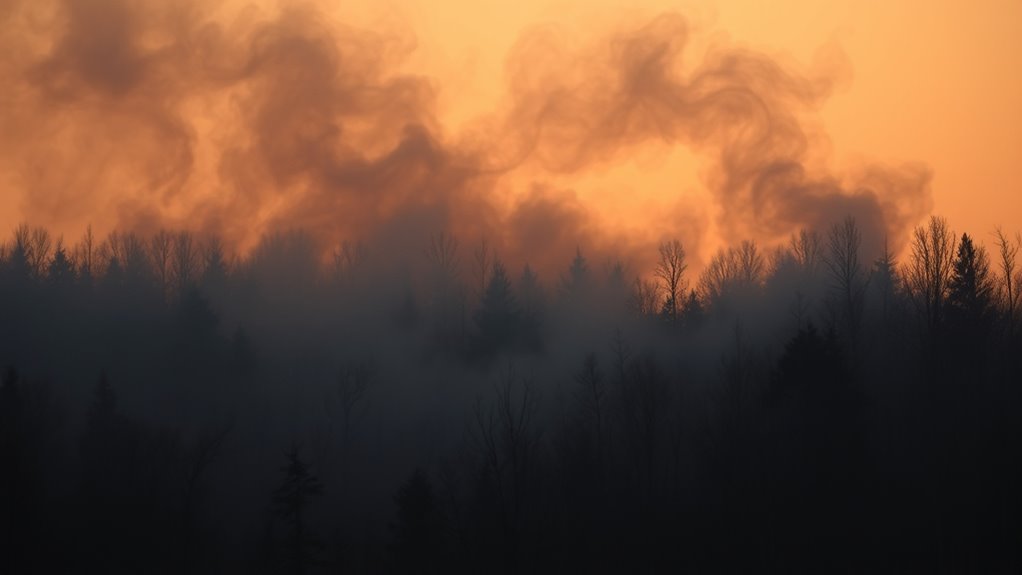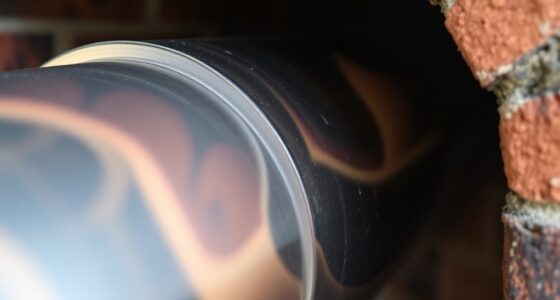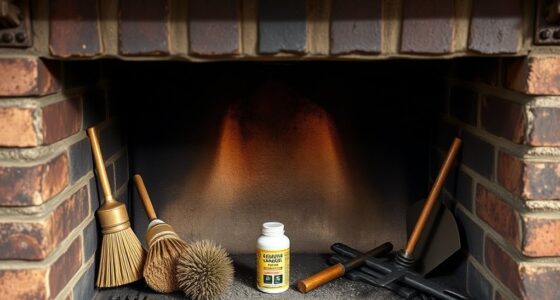Exposure to wood smoke and PM2.5 can seriously harm your health, especially if you have respiratory issues or vulnerable loved ones like children and seniors. These tiny particles can penetrate deep into your lungs, causing inflammation, irritation, and worsening conditions like asthma or COPD. Continuous exposure may lead to long-term lung problems and increased infection risk. Understanding these risks helps you take steps to protect yourself and your family from indoor air pollution. If you explore further, you’ll discover ways to improve your indoor air quality and health.
Key Takeaways
- Wood smoke releases PM2.5 particles that can penetrate deep into the lungs, causing inflammation and respiratory irritation.
- Exposure increases risks for respiratory conditions like asthma and COPD, worsening symptoms and lung function over time.
- Vulnerable groups such as children and the elderly are at higher risk of severe health effects from indoor wood smoke.
- Proper ventilation, air purifiers, and clean-burning stoves can reduce indoor PM2.5 levels and health risks.
- Chronic exposure may lead to long-term health issues, including decreased lung capacity and increased respiratory infections.

Wood smoke and PM2.5 particles pose significant health risks, especially for vulnerable populations like children, the elderly, and those with preexisting health conditions. When you’re exposed to these pollutants indoors, your indoor air quality can quickly decline, affecting your respiratory health in ways that might not be immediately obvious. Unlike outdoor pollution, which can sometimes be diluted by fresh air, indoor air pollution from wood burning tends to concentrate, making it easier for harmful particles to be inhaled deeply into your lungs. This is especially concerning if you heat your home with wood stoves or fireplaces regularly. The tiny PM2.5 particles are small enough to bypass your nose and throat defenses, penetrating deep into your respiratory system and causing inflammation and irritation.
Indoor wood smoke and PM2.5 particles can severely harm your lungs, especially for vulnerable groups.
If you or someone in your household has asthma, COPD, or other respiratory conditions, the impact of wood smoke can become even more severe. You might notice increased coughing, wheezing, or shortness of breath after exposure. Over time, repeated inhalation of these fine particles can lead to chronic respiratory problems, reducing your overall lung function. Children are particularly vulnerable because their respiratory systems are still developing, and they breathe more air relative to their body size. Exposure to wood smoke can hinder lung growth and increase the risk of respiratory infections. For the elderly, who often have weakened immune systems or existing health issues, inhaling PM2.5 can trigger more frequent or severe episodes of respiratory distress.
Maintaining good indoor air quality is vital to protecting your respiratory health. Proper ventilation, air purification, and regular cleaning can reduce the concentration of wood smoke particles indoors. If you use a wood stove, ensure it is well-maintained and that you burn only seasoned, dry wood to minimize smoke emissions. Avoid indoor smoking and reduce other sources of indoor pollution that can compound the effects of wood smoke. Recognize the signs of compromised air quality, such as persistent cough, nasal congestion, or eye irritation, and address them promptly to prevent long-term health consequences. Using air purifiers with HEPA filters can significantly decrease indoor PM2.5 levels and improve overall air quality.
Ultimately, understanding how wood smoke impacts indoor air quality and respiratory health helps you take proactive steps to safeguard yourself and your loved ones. By reducing indoor exposure, you protect your lungs from harmful particles and promote a healthier living environment. Taking these precautions is especially important during colder months when wood heating is common, and indoor air quality can deteriorate quickly. Your respiratory health depends on your awareness and actions to keep your indoor air clean and free from the hazards of wood smoke and PM2.5.
Frequently Asked Questions
How Does Outdoor Wood Smoke Impact Urban Air Quality?
Outdoor wood smoke markedly impacts your urban air quality by adding to pollution sources that degrade the air you breathe. When wood fires burn, they emit PM2.5 particles and other pollutants, increasing smog and health risks. These pollution sources can overwhelm local efforts to maintain clean air, making it harder for you to enjoy safe, healthy environments. Reducing wood smoke emissions helps improve overall air quality for everyone.
Are Children More Vulnerable to PM2.5 Exposure From Wood Smoke?
Yes, children are more vulnerable to PM2.5 exposure from wood smoke because their developing lungs and immune systems are more sensitive. You should be aware that this exposure can lead to developmental impacts, affecting lung growth and increasing respiratory issues. As a parent or caregiver, minimizing their exposure is essential, especially during high wood smoke periods, to protect their health and support healthy development.
Can Indoor Wood Burning Be Made Safer With Filters or Ventilation?
Yes, indoor wood burning can be made safer with proper filtration and ventilation strategies. You should use indoor filtration systems, like HEPA filters, to reduce PM2.5 levels effectively. Additionally, improving ventilation by opening windows or installing exhaust fans helps dilute smoke particles in the air. Combining these measures minimizes your exposure to harmful wood smoke, making your indoor environment healthier for everyone, especially children.
What Long-Term Health Conditions Are Linked to PM2.5 Exposure?
Imagine breathing in high levels of PM2.5 daily, increasing your risk of developing long-term health issues. Exposure is linked to chronic respiratory conditions like asthma and COPD, making it hard to breathe over time. It also raises your chances of cardiovascular diseases, such as heart attacks and strokes. Reducing exposure is essential to protect your health, especially if you’re in environments with persistent air pollution.
How Do Weather Patterns Influence Wood Smoke Dispersion?
Weather patterns substantially influence how wood smoke disperses. You’ll notice that airflow dynamics, such as wind speed and direction, determine how quickly and far smoke spreads. Temperature inversions, where a layer of warm air traps cooler air near the ground, can cause smoke to accumulate, worsening air quality. To reduce exposure, pay attention to these patterns, especially during calm, stable weather when smoke tends to linger longer.
Conclusion
You might not realize it, but every time you breathe in wood smoke and PM2.5, you’re risking your health. It’s strange how something so common can silently impact your lungs and overall well-being. Sometimes, the tiniest particles cause the biggest problems, yet we overlook them. Staying aware of these invisible threats helps you protect yourself. After all, in a world full of surprises, safeguarding your health shouldn’t be one of them.











